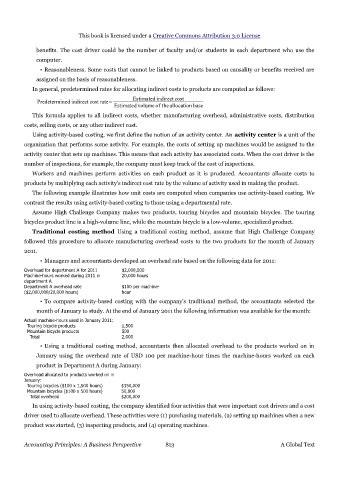Page 812 - Accounting Principles (A Business Perspective)
P. 812
This book is licensed under a Creative Commons Attribution 3.0 License
benefits. The cost driver could be the number of faculty and/or students in each department who use the
computer.
• Reasonableness. Some costs that cannot be linked to products based on causality or benefits received are
assigned on the basis of reasonableness.
In general, predetermined rates for allocating indirect costs to products are computed as follows:
Estimated indirect cost
Predetermined indirect cost rate=
Estimated volume of theallocation base
This formula applies to all indirect costs, whether manufacturing overhead, administrative costs, distribution
costs, selling costs, or any other indirect cost.
Using activity-based costing, we first define the notion of an activity center. An activity center is a unit of the
organization that performs some activity. For example, the costs of setting up machines would be assigned to the
activity center that sets up machines. This means that each activity has associated costs. When the cost driver is the
number of inspections, for example, the company must keep track of the cost of inspections.
Workers and machines perform activities on each product as it is produced. Accountants allocate costs to
products by multiplying each activity's indirect cost rate by the volume of activity used in making the product.
The following example illustrates how unit costs are computed when companies use activity-based costing. We
contrast the results using activity-based costing to those using a departmental rate.
Assume High Challenge Company makes two products, touring bicycles and mountain bicycles. The touring
bicycles product line is a high-volume line, while the mountain bicycle is a low-volume, specialized product.
Traditional costing method Using a traditional costing method, assume that High Challenge Company
followed this procedure to allocate manufacturing overhead costs to the two products for the month of January
2011.
• Managers and accountants developed an overhead rate based on the following data for 2011:
Overhead for department A for 2011 $2,000,000
Machine-hours worked during 2011 in 20,000 hours
department A
Department A overhead rate $100 per machine-
($2,000,000/20,000 hours) hour
• To compare activity-based costing with the company's traditional method, the accountants selected the
month of January to study. At the end of January 2011 the following information was available for the month:
Actual machine-hours used in January 2011:
Touring bicycle products 1,500
Mountain bicycle products 500
Total 2,000
• Using a traditional costing method, accountants then allocated overhead to the products worked on in
January using the overhead rate of USD 100 per machine-hour times the machine-hours worked on each
product in Department A during January:
Overhead allocated to products worked on in
January:
Touring bicycles ($100 x 1,500 hours) $150,000
Mountain bicycles ($100 x 500 hours) 50,000
Total overhead $200,000
In using activity-based costing, the company identified four activities that were important cost drivers and a cost
driver used to allocate overhead. These activities were (1) purchasing materials, (2) setting up machines when a new
product was started, (3) inspecting products, and (4) operating machines.
Accounting Principles: A Business Perspective 813 A Global Text

